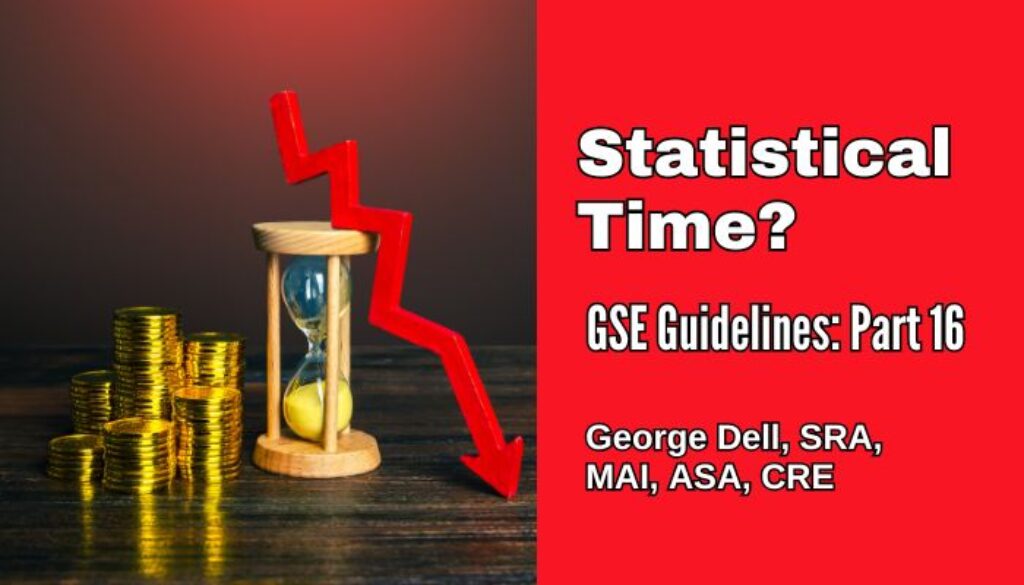Statistical is the second “method” mentioned in the Fannie Mae Guideline for time adjustments.
Editor’s Note: Read the entire series (so far) here.
What does that mean? Is it an actual “acceptable” method? It says so. It must be!
Let’s look.
The Fannie Mae Guidelines do not explain the word, nor the process. We must look elsewhere.
“Statistical” means having to do with statistics. Duh.
“Statistics” per Merriam-Webster is “a branch of mathematics dealing with the collection, analysis, interpretation, and presentation of masses of numerical data.”
Wow! Sounds like the whole appraisal process. Got it. Statistical means I can use the appraisal process to calculate time adjustments. Cool!
But I need to know an acceptable method. Not a sweeping generalization that misses the dustpan. I need a real dustpan to catch my statistical dust.
In the Appraisal Institute’s Appraisal of Real Estate, (ARE) 15th ed., p.372, nearly a full page is devoted to “Data Analysis Techniques” in the Comparative Analysis Chapter 21.
In the next section of that chapter, Statistical analysis: “An appraiser can develop a series of adjustment factors to control for different tract sizes by creating a simple linear regression model and then use the results of the regression analysis as a means of inferring the size adjustment for properties within the range of the data. If a reasonable pattern emerges, the model can be applied to a group of sales with differing land sizes to test its accuracy, although the process might also demonstrate that the indicated adjustments are incorrect.”
So, you can do it, but it might be incorrect . . .
The ARE goes on to say:
“Appraisers should recognize the differences between statistical processes in the collection and description of data and should be able to distinguish between descriptive and inferential statistics. Without an understanding of these basic issues, any use of statistical calculations is dangerous or ill-advised.”
Hmmm — incorrect, dangerous, ill-advised . . .
But we want to use “statistical” as a method! I found that the simplest definition of “statistics” is that it is the study of data. Turn masses of data into useful information, into knowledge, into decision-making.
The data we have is simple: 1) the date of sale; 2) the sale price. The relationship is simple: how do these two variables relate to each other? How about cause and effect? Simple again. Prices do not cause dates. Price levels vary with time (dates). Easy. Time is the predictor variable, measured in days. Price is the predicted variable — measured in dollars. We want a result of the change (of the market segment) in dollars per time period. Easy again. (All we gotta do is deal with the “noise.”)
If we know cause and effect, and the relationship (say linear), simple regression answers. Regression is part of the study of statistics. AND, we have a picture – a scatterplot. With pretty colors even.
Let’s keep going . . .
Our next fun and “acceptable method” from Fannie Mae is — modeling.

March 10, 2025 @ 5:08 pm
Well, George it finally happened, I was threatened to be removed from a panel from one of the largest lenders in Canada because I refused to make unsupported adjustments. To be clear, these were simply adjustments for the sake of adjustments. There was no issue with the value or any other issue. It’s a rural property with extremely limited comps. The date of sale adjustment was zero, not empty, zero. The overall market had been fairly stable over the past year, maybe a few percent fluctuations month over month, and about the same year over year. They said they would find an appraiser who would make adjustments. So in their mind a report with unsupported adjustments is better than one with rational qualitative conclusions. This sets the stage for the manipulation of reporting, for the pull down method, for the adjustment list. Make adjustments, so it looks good. Don’t upset the apple cart….. to be continued.